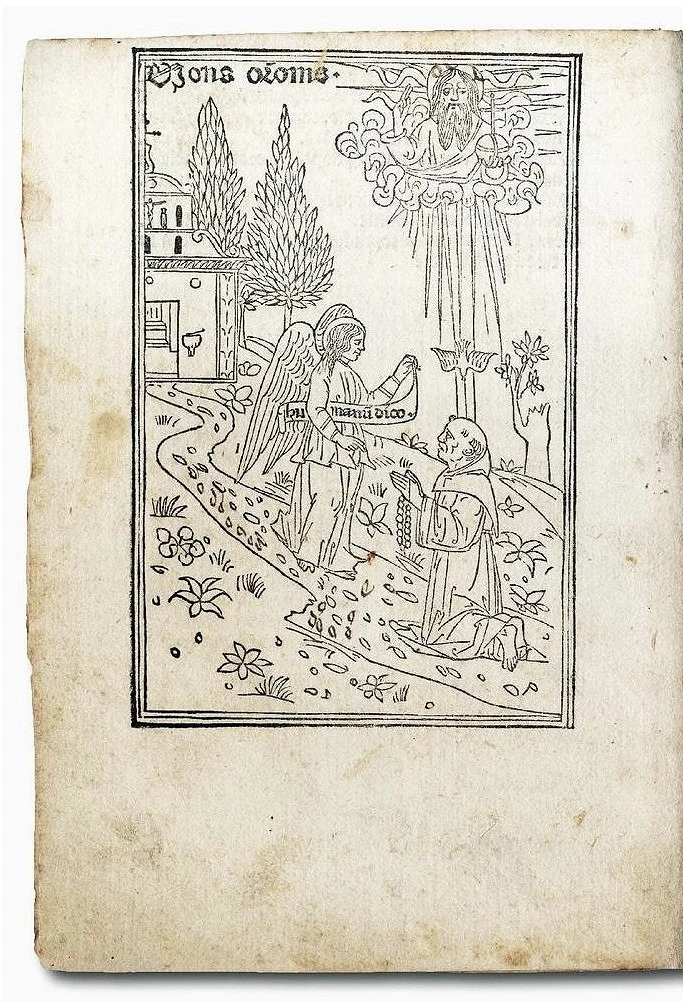Early Pictorial Paper Bindings
Upper cover of Monte de la oratione [Venice, Bernardinus Benalius (?), before June 1493].
Early paper bindings with woodcuts are very rare, and of the greatest importance in the history of engraving as well as the study of marketing strategies in print culture.
A fine example of a pictorial paper wrapper is on the 1493 Venetian edition of the Monte de la oration, an allegorical narrative of the soul’s ascent to Heaven which became widespread in the Franciscan milieu (for the description click here). Its printing is generally attributed to Bernardino Benali (Benalius), a native of Bergamo who specialized in the production of illustrated books and devotional editions in the Italian vernacular. In 1483 Benali was already active as a binder as well as a printer, “in Marzaria, tien per insegna sancto Girolamo”, a phrase he also reused for one of his typographical devices. Benali continued to print as late as 1524 in his workshop near San Pantalon Church, although his publishing activity had slowed significantly.
The upper cover of the Monte de la oration’s paper wrapper features a woodcut of a desert landscape in which St. John the Baptist, with the Agnus Dei, and St. Peter, holding the keys to the kingdom of Heaven, are depicted supporting intertwined foliate circles symbolic of the Trinity. The woodcut on the lower cover depicts St. John the Evangelist, with his eagle, and St. Francis of Assisi, with his stigmata, standing before a chapel; again the saints are depicted supporting three foliate circles, along with the name and virtue of the Virgin, according to the iconographical tradition of showing Mary’s familial relations to the Trinity that was typical of Franciscan imagery. Benali’s edition also contains a full-page woodcut introducing the text and bearing the inscription ‘Mons orationis’. This woodcut depicts an angel holding a scroll with the inscription ‘humanum dico’ (Rom. 6:19), a Franciscan monk praying with a rosary in his hands, and a small church in the background symbolic of the entrance to Heaven; above, the Father is represented performing a blessing while holding the globus cruciger, or cross-bearing orb, and the Holy Spirit.
Lower cover woodcut featuring St. John the Evangelist, St. Francis of Assisi, and the Virgin’s familial relations in a foliate Trinity.
Introduction woodcut with an angel, a monk, and a representation of the Father performing a blessing.
The woodcuts illustrating the boards of the Monte de la oration likely belonged to Benalius himself, who re-used them for the covers of two contemporaneous editions, the Fioretti by St. Francis of Assisi, which appeared on 11 June 1493, and the Zardin de Oration Fructuoso by the Franciscan Niccolò di Osimo (Nicolaus de Ausmo), which was issued in 1494. This pictorial paper binding thus came to serve as a sort of ‘eye-catching advertisement’ for publications whose content was related to Franciscan piety and morality. Both the Fioretti and the Zardin de Oration Fructuoso also contain the woodcut employed by the Venetian printer for introducing the text of the Monte de la oration (though of course with the inscription ‘Mons orationis’ removed).
Missae in agenda defunctorum tantum deservientes. Ex Missali Romano recognito desumptae, cum Ordinario, et Canone, ut in ispis servatur: ad usum, et commoditatem omnium Ecclesiarum. Bologna, Giulio Borzagni, 1690.
Missae in agenda defunctorum tantum deservientes juxta usum Ecclesiae Romanae cum Ordine et Canone extensae. Bologna, Lelio dalla Volpe, 1744.
Pictorial paper wrappers were employed throughout the centuries for binding popular histories, small devotional and liturgical publications, pamphlets, almanacs and other ephemera. These booklets were printed on rough paper, and the limp boards were illustrated with woodcuts that were frequently re-used. Despite their common usage, the fragility of the material means that surviving examples of paper-covered books are extremely rare. This is also the case for two funerary bindings with illustrated limp boards, produced in Bologna in 1690 and 1744, respectively, which contain the text of the Mass for the Dead, taken from Roman Missal (for the descriptions click here). These boards bear woodcuts inspired by the iconography of the memento mori (‘remember that you will die’), widely popular during the Counter-Reformation, which includes commonplace symbols of mortality such as skulls, skeletons, and bones, along with objects that recall the vanity of worldly goods and pleasures. This standard, easily recognizable iconography was also adopted by printers. Thus, in effect, these paper bindings are not only an example of funerary art, but also served as a reminder of one’s mortality, which would immediately reveal – once again in the form of a compelling ‘eye-catching advertisement’ – the content and purpose of the publication issued from their printing houses: the Requiem mass.
How to cite this information
Margherita Palumbo, "Early Pictorial Paper Bindings," 14 August 2019, www.prphbooks.com/blog/2019/8/9/benaliwrappers. Accessed [date].This post is licensed under CC BY-SA 4.0.
![Upper cover of Monte de la oratione [Venice, Bernardinus Benalius (?), before June 1493].](https://images.squarespace-cdn.com/content/v1/5c748f03aadd346d92d68bd1/1565374876277-KYJRV5I77VXY9NKV80XP/Benali+cover.jpg)



